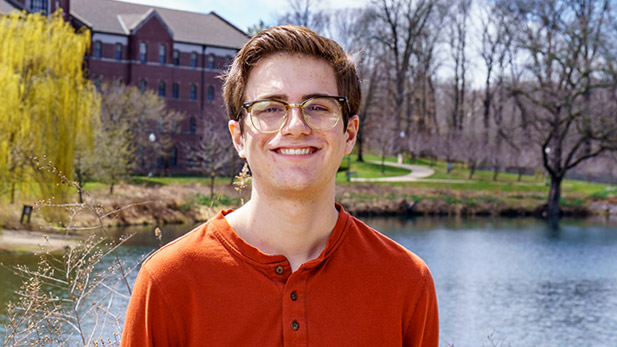2022 Goldwater Scholar Nathan Hurtig Flourishes as Undergraduate Researcher

Rose-Hulman sophomore computer science major Nathan Hurtig has already participated in two undergraduate research opportunities, presented at a national conference, won second place for his work. He was also named a 2022 Barry Goldwater Scholar.
Nathan Hurtig may only be a sophomore at Rose-Hulman, but what he has accomplished in just two years is something, he believes, would never have happened had he attended another college. This computer science major has already participated in two undergraduate research opportunities, presented at a national conference, won second place for his work and has several more opportunities on the horizon. He was also named a 2022 Barry Goldwater Scholar, a distinguished academic award rarely given to sophomores.
Originally from Ada, Ohio (home of the Wilson Football Factory that makes all NFL footballs), Hurtig chose Rose-Hulman for its small class size and the opportunity it provides to have one-on-one interactions with professors. He originally wanted to pursue a degree in mathematics but decided computer science would present more opportunities for research and career.
His first introduction to research came from Associate Professor of Computer Science and Software Engineering Joe Hollingsworth, PhD, during his first quarters at Rose. Hollingsworth asked Hurtig to work on the research project that Hurtig calls “Thought Network.” The impetus behind Thought Network is to help educators understand what students are thinking when they answer questions through online learning platforms.
“Right now, instructors look at what a student is inputting into the server and the student gets immediate feedback that it’s either right or wrong,” Hurtig says. “But the instructor doesn’t know what the student is thinking or how they got to that answer. That’s difficult to achieve without in-person interaction. So, I’m trying to formalize the data from these online tools and then turn it into something useful and visual that instructors can use to teach students.”
An example of this online learning is what Hurtig describes as the “try, try again” online tool where a student inputs their answer into a text box. They try various answers until they get the correct one. What Hurtig has done is used computer programming to create grids and charts that map out students’ answers and show patterns of how they came to the correct answer. The instructor can then use those patterns and see how students are thinking, and as a result, can address that disconnect in lectures or office hours.
He is also working on training the computer to notice when a student is struggling and remedy that before they fall too far behind in the work. The computer would make suggestions such as reread the directions or point the student to an easier lesson before tackling more difficult material. Hurtig would ultimately like to deploy Thought Network into existing online learning programs.
He presented Thought Network at the Association for Computing Machinery's Special Interest Group on Computer Science Education (SIGCSE) Conference in Providence, Rhode Island in March and won second place in the student research competition. The presentation garnered interest from the session chair, who asked Hurtig to deliver the presentation to his research group at the University of Florida. Hurtig is also presenting a paper about Thought Network at an online conference in Tunisia, North Africa, as well as at an in-person conference in Dublin, Ireland, this summer.
Hurtig’s second research endeavor was through a National Science Foundation-sponsored research experience for undergraduate (REU) project at Florida Atlantic University. For 10 weeks last summer, Hurtig and a student from Brigham Young University built a robot to simulate pedestrian traffic to test cell phone signal power in an area of West Palm Beach. That data, in turn, showed city planners how busy intersections were and whether there was a need for crosswalks and traffic light time changes. Hurtig will co-present a research paper about this project to the Association for Computing Machinery (ACM) Southeast conference in spring 2022.
Hurtig plans to continue his undergraduate research and already secured a second REU opportunity, this one in math, at University of Maryland next summer. There is no doubt in his mind that the faculty interaction that Rose provides is what led him to myriad research opportunities he’s had.
“Without me getting to know Professor Hollingsworth and him reaching out to me, I would not have any of these opportunities … and they keep coming,” he says. “It’s all a result of that relationship with my professor.”
When he is not conducting research or in class, Hurtig keeps busy in campus extra-curricular activities. He is part of the saxophone ensemble, plays clarinet in concert band, as well as bass clarinet in the Rose orchestra. Hurtig also enjoys working as a teaching assistant (TA). During the winter quarter, he assisted a computer science professor create an auto-grading tool that grades student homework and exams for a PLC course. He also works as a lab TA one night per week. Hurtig is also a Noblitt Scholar and credits the program for its generosity in funding his trip to the SIGCSE Conference in Providence.